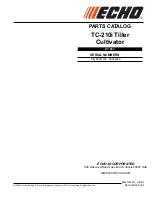
7
Starting and stopping the engine
Remember: Always check the oil level prior to use!
The oil level must always be between the min. and max.
Mark on the dipstick. Always use SAE-30 oil. Use only
unleaded 95 octane gas. Never over-fill the gas tank.
Warning: Stay out of dashed zone, while starting the engine!
Always start the engine from dotted operation zone See
Figure 8.
Starting the engine
1. Set the throttle control on the handle to max.
2. Position the choke at max. Move the choke lever fully to
the left. The choke is not required if the motor is hot.
3. Pull the start cord to start the motor. Always feed the
start cord back into the motor by hand.
4. When the motor is started, set the choke to minimum
Engage the throttle slightly.
Stopping the engine
1.
Set the throttle control to “low” and let the motor run for
approx. 30 seconds.
2. When the motor idles, set the throttle control to full stop.
Vibrations may travel up into the handle during
use. We therefore recommend taking a break
every 2 hours.
Cleaning the tiller
The tiller should be cleaned after use. Use a garden hose to
wash off soil and dirt. Remove any grass, etc. from the rotor
shaft. The chassis number should only be cleaned with a
damp cloth to avoid unnecessary wear. Avoid using a high-
pressure washer during cleaning.
Changing the oil
The oil should initially be changed after the first 5 hours of
use, and thereafter once per year.
1. Let the motor run for 5 minutes to heat up the oil.
This allows the oil to run more freely and makes for
a more complete oil change.
2. After 5 minutes, stop the motor. Remove the spark
plug cap. Drain the oil by unscrewing the sump plug.
Remember to drain the oil into a container of
sufficient capacity. NB: The motor must not be
tipped backwards more than 45 degrees.
3. Screw the sump plug back in and pour new oil into
the motor. Do this by removing the dipstick and
pouring in the recommended quantity of oil.
4. Refit the spark plug cap.
Alternatively, use an oil change pump kit.
1. Suck the oil up through the oil filler hole using the
syringe. Use the hose to reach the sump.
2. Transfer the used oil to the container.
3. Fill the engine with new SAE-30 oil.
4. Check the oil level using the dipstick.
Remember to dispose of used oil in an ecologically sound
manner .Oil and oil pump kit is not included.
Spark plug maintenance
•
Remove the spark plug cap.
•
Brush away any dirt and deposit of the spark plug.
•
Loosen the spark plug using a spark plug socket.
•
Check the insulation is intact.
•
Clean the spark plug using a wire brush.
•
Measure the electrode gap 0.7
–0.8 mm.. Avoid
damaging the electrode.
•
If it is damaged, replace it with a new one.
•
Refit the spark plug.
•
Refit the spark plug cap.
Storage
•
If the machine is likely to be stored unused for
prolonged periods, follow the instructions below.
This will ensure longer machine lifetime.
•
Use a garden hose to wash off soil and dirt.
Remove any grass, etc. from the rotor shaft. The
chassis number should only be cleaned with a
damp cloth to avoid unnecessary wear. Avoid using
a high-pressure washer during cleaning.
•
Wipe the tiller with a damp cloth so that all surfaces
are clean. Wipe the surfaces down with an oily cloth
to prevent rust.
•
Always store the machine in a dry, clean location.
Troubleshooting
The motor will not start
1. Check the fuel control is set correctly.
2. Check the spark plug.
3. Check there is fresh gas in the tank.
4. See separate motor instructions for further
troubleshooting.
The motor is not running smoothly
1. Ensure the throttle control is not set to max.
2. Check there is fresh gas in the tank.
The blades will not rotate
1. Check for stones lodged between the blades.
2. Release any stones by removing the blades.
3. Check the cables are in good working order and
fitted correctly.
4. Check the belt is in good working order and fitted
correctly.
5. Ensure the belt tensioner is adjusted correctly.
The blades will not stop
1. Stop the engine and contact your dealer.
Noise, vibration and precautionary measures
1. Long-term exposure to noise levels exceeding 85
dB (A) are damaging. Always use ear defenders
when the machine is being used.
2. Reduce the running speed of the motor to reduce
vibration and noise levels.
3. To reduce noise levels further, only use the machine
in an open environment.
4. Vibrations can be reduced further by holding the
handle firmly.
5. To avoid disturbing others, the machine should only
be used during the daytime.
6. Always wear close-fitting work clothes, hard-wearing
work gloves, ear defenders and non-slip boots with
steel toecaps.
7. Take a 30-minute break every 2 working hours.











































